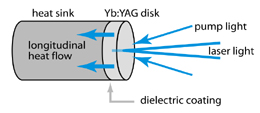Optipedia • SPIE Press books opened for your reference.
Thin-Disk Lasers
Excerpt from Field Guide to Lasers
 The gain medium of a thin-disk laser (or disc laser, active mirror laser) is a laser crystal (often Yb:YAG) in the form of a disk with a thickness of 100-200 µm, which is fixed on a water-cooled heat sink. The cooled end face has a dielectric coating that reflects both the laser radiation and the pump radiation.
The gain medium of a thin-disk laser (or disc laser, active mirror laser) is a laser crystal (often Yb:YAG) in the form of a disk with a thickness of 100-200 µm, which is fixed on a water-cooled heat sink. The cooled end face has a dielectric coating that reflects both the laser radiation and the pump radiation.
The heat is extracted dominantly through the cooled end face, and because the disk thickness is considerably smaller than the laser beam diameter, the heat flow is largely in the direction of the beam, rather than in a transverse direction, as for a laser rod. As a consequence, thermal lensing is weak.
The small disk thickness, as required to limit the heating, leads to incomplete pump absorption in a double pass. Therefore, one usually uses some multipass pumping scheme, which can be realized with very compact optics.
Thermal lensing is not only weak, but it also scales in a benign way: when increasing the pumped area in proportion to the power throughput, the dioptric power of the thermal lens gets even smaller. As long as stress effects are negligible, this just compensates for the higher sensitivity of a larger resonator mode. Furthermore, the temperature rise in the disk is hardly increased, as the cooled area is also enlarged. Due to this power scaling behavior, thin-disk lasers with diffraction-limited beam quality can be built for output powers between tens of watts and many kilowatts, essentially by adjusting the diameter of the pumped spot.
Q switching is possible with high pulse energies but not with very short pulses because the laser gain is quite limited.
R. Paschotta, Field Guide to Lasers, SPIE Press, Bellingham, WA (2008).
View SPIE terms of use.

